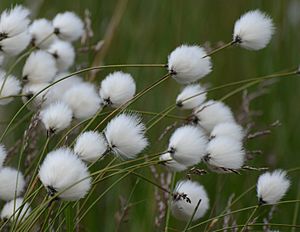Eriophorum facts for kids
Quick facts for kids Eriophorum |
|
|---|---|
 |
|
| Eriophorum vaginatum with its fluffy seed heads. | |
| Scientific classification |
|
| Kingdom: | Plantae |
| Clade: | Tracheophytes |
| Clade: | Angiosperms |
| Clade: | Monocots |
| Clade: | Commelinids |
| Order: | Poales |
| Family: | Cyperaceae |
| Genus: | Eriophorum L. |
| Type species | |
| Eriophorum vaginatum L.
|
|
| Synonyms | |
|
|
Eriophorum (also known as cottongrass or cotton-grass) is a group of flowering plants. They belong to the Cyperaceae family, which is also called the sedge family. You can find these plants in cold, northern parts of the world. They grow in places like the Arctic, subarctic, and temperate zones of the Northern Hemisphere. Cottongrass especially loves wet, acidic bogs and is very common in Arctic tundra areas.
Contents
What is Cottongrass?
Cottongrass plants are herbaceous perennial plants. This means they are non-woody plants that live for more than two years. They have thin leaves that look a lot like grass. The most special part of these plants is their seed heads. These heads are covered in a soft, fluffy material that looks just like cotton.
How Cottongrass Spreads and Stays Warm
The fluffy, cotton-like fibers on the seed heads are very important. They help the plant's seeds travel far away. The wind easily picks up these light, cottony masses and carries the seeds to new places. This helps the plant spread and grow in many areas.
In very cold Arctic regions, these fluffy fibers have another cool job. They act like a warm blanket, similar to down feathers. These see-through fibers trap heat from the sun. This helps to keep the plant's reproductive parts warm during the short Arctic summer. This extra warmth is very important for the plant to grow and make new seeds.
Size of the Plant
Cottongrass plants usually grow to be about 12 inches (30 cm) tall. They can also grow in water that is around 2 inches (5 cm) deep. Their size helps them fit well into their wet, boggy homes.
Uses of Cottongrass
For a long time, people have found different ways to use cottongrass. Its fibers are strong and soft, making them useful for various things.
Historical Uses of the Fibers
In the past, people used the fibers from cottongrass to make paper. They also used them to make wicks for candles. Wicks are the parts of candles that burn. The soft material was also used to stuff pillows, making them comfortable.
Traditional Medicine Uses
Long ago, some parts of the cottongrass plant were used in traditional medicine. The leaves were sometimes used to help treat diarrhea. The soft, spongy inside part of the stem, called the pith, was also used. It was thought to help remove tapeworms from the body.
Selected Cottongrass Species
There are many different types of cottongrass plants. Here are a few examples of the species found around the world:
- Eriophorum angustifolium – found across Europe, Asia, and North America.
- Eriophorum brachyantherum – grows in Scandinavia, northern Russia, and parts of North America.
- Eriophorum chamissonis – found in Siberia, Alaska, Canada, and parts of the United States.
- Eriophorum gracile – common in Europe, Asia, and North America.
- Eriophorum latifolium – found in much of Europe and parts of Asia.
- Eriophorum scheuchzeri – grows in Europe, Asia, and North America, especially in mountains.
- Eriophorum vaginatum – one of the most widespread species, found in most places where cottongrass grows.
- Eriophorum virginicum – found in eastern North America.
See also
 In Spanish: Eriophorum para niños
In Spanish: Eriophorum para niños

